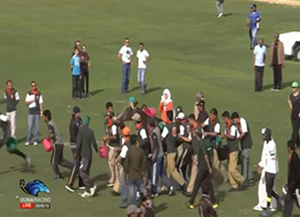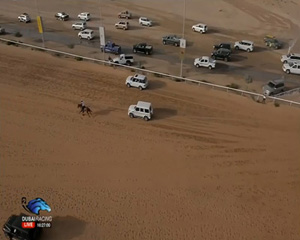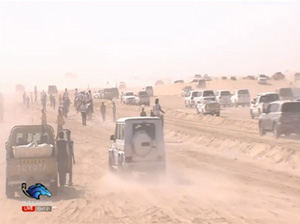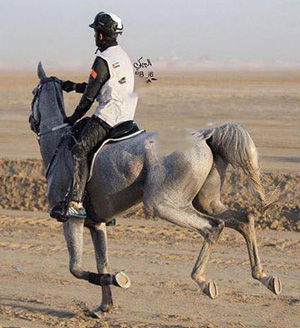In Middle East endurance, the number of FEI disqualifications and yellow cards dished out are inversely proportional to the number of offences occurring.
Dip randomly into any live-stream from the Middle East winter season, or any collection of photographs, of which thousands are archived on the websites of commercial snappers, and you’ll come across aberrations like this without even trying. No wonder no one bothers to attempt enforcement amid all this mayhem. You’d hardly know where to start.
No, this is not a scene from Arachnophobia. This horse is looking like an insect due to the bizarre Group 7 fad for duct-taping blinkers and visors to limit vision to a weeny slit. Admittedly, there is not much to look at the desert, so he’s not missing out, but it’s no time for flippancy. This is an unkind means of de-sensitising the horse (note also the earplugs), resulting presumably from his rider’s inability to keep the horse’s mind on the job through sympathetic means. This poor fellow, Embrujo, completed the 160k Presidents Cup in this blinding garb, though some shots from the later stages show the slit had been widened by about an inch.
If something is not specified in FEI rules, it’s generally assumed the matter not mentioned is thereby allowed. But when FEI rules were written, no one could possibly have predicted the sort of warped imagination that would come up with this. As a top eventing judge said to me recently, “Just because FEI rules don’t say you must not drape a pair of knickers over your top hat, it does not follow that anyone would do it!”

Lowering the horse’s head is meant to cause a relaxation reflex in the hopes of lowering their heart rate.
Interestingly, the UAE federation issued a ban on duct-taping at national level a year ago – and then promptly failed to apply it. This in itself did not prod the FEI to take a view about horses not being allowed a view.
The FEI originally told me that duct-taping will be discussed at an in-person meeting at the end of April (i.e., at the FEI forum in Lausanne, because no one could be troubled to tackle UAE before then). But today, and only because the surreal shot of Embrujo has gone viral, the FEI has advised it will consult officials at the Presidents Cup as a matter of urgency.
People sometimes ask me why I don’t write something positive about what the FEI is trying to do. I’ll tell you what will be news: the day the FEI reacts to an endurance outrage without having to dragged into it, kicking and screaming, by the weight of public opinion. But I don’t expect to be writing such a piece any time soon.
Aaah. Some people really love their horse. Or do they? Is this a cosy moment or the sleight of hand (above right), trying to lower the horse’s head at the vet-gate in an attempt to get the heart rate down? The theory is that the position triggers a primeval reflex in the horse who thinks he is safe from predators (what an irony!) if he is grazing: ergo, he relaxes. Shouldn’t officials be cautioning against it?
Ear-pulling is something most of us to do show affection to our trusty steeds, but again there is a difference between caressing ears and forcing them back. This instance is pictured approaching a vet-gate, another tactic linked to the theory it reduces heart rate, and that thus you will get through that test quicker. There are also ample pictures doing the rounds on Facebook of the same practice in a vet-gate. Stapling of the ears is believed to have a similar effect.

It is not uncommon to see an overwhelming number of crew members, despite a rule that limits crews to five people per horse.
In February 2013, the FEI met UAE representatives and the latter allegedly undertook to drastically reduce crew sizes in vet-gates. We know this because the FEI mentioned it to the Swiss federation in a letter sent a few weeks later, as an example of perceived progress. Needless to say, it remained business as usual throughout 2013 and 2014, with the human wall continuing to conceal goodness-knows-what, despite FEI rules expressly saying the horse must be clearly visible at all times in the gates. An actual rule applied on August 1st limited crew to five per horse. But again there are still more examples of human walls photographed at FEI rides during this current winter season than there are four wheel drives on the piste…

The FEI has disclosed that Sheikh Mohammed was in one of the vehicles seen in this photo, chasing after a horse as it approached the finish line in the Sheikh Mohammed Cup.
…which brings us to this. The battalion of four-wheel drives chasing down the hapless horses and kicking up a dust storm has become a pivotal part of the desert day out for the best part of two decades. Cars seem to out-number the horses 10 to one, though, as we saw in the case of Splitters Creek Bundy, there’s never a vet on board when you need one.
FEI rules expressly ban vehicles from following on or adjacent to the course, but you can show the FEI any number of pictures just like these and they will flatly deny there’s anything amiss. Asked to comment on the image atright, captured from the Dubai Racing TV live-stream of the Sheikh Mohammed Cup last month, the FEI told me Moh himself was in one of the cars, because it was approaching the finish. So that makes it alright then.

Allowing vehicles, which outnumber horses 10-1, to chase them throughout the race is also common place.
In the other still pictures, we see horses and vehicles jostling for position on the track. I’m told that some bright spark thought a gesture should be made towards slowing horses down, achieved by applying an extra layer of deeper sand – the tracks are graded right down even though there should be not attempts to encourage fast times, according to the rules. So riders simply moved over to the firmer vehicle track.
As for this video clip from the President’s Cup last weekend, 10 points to anyone who manages to spot the horse.
Meanwhile, an actual world-first: An endurance rider from Group 7 has posted a comment to a photograph of the stricken Bundy on Instagram. Even though his English isn’t good, I think he confirms what we already know: they simply don’t get why the rest of the world is appalled. Mohammed Al Abbar writes: “Who cares. Thing [sic] about people and children who are dying, u just don’t have anything to do and put this picture injuries and fractures happens y not u look at flat racing look homany break their….”
There’s no point even trying to dignify this with a response.


